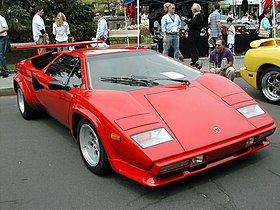Lamborghini Countach
| Lamborghini Countach | |
|---|---|

Lamborghini Countach LP500 S
|
|
| Overview | |
| Manufacturer | Lamborghini |
| Production | 1974–1990 (2,049 produced) |
| Assembly | Sant'Agata Bolognese, Italy |
| Designer | Marcello Gandini at Bertone |
| Body and chassis | |
| Class | Sports car (S) |
| Body style | 2-door coupé |
| Layout | Longitudinal mid-engine, rear-wheel-drive |
| Powertrain | |
| Engine |
Lamborghini V12 LP400, LP400 S: 3929 cc LP500 S: 4754 cc 5000 QV, 25th Anniversary: 5167 cc |
| Transmission | 5-speed manual |
| Dimensions | |
| Wheelbase | 2,450 mm (96.46 in) |
| Length | 4,140 mm (162.99 in) |
| Height | 1,070 mm (42.13 in) |
| Chronology | |
| Predecessor | Lamborghini Miura |
| Successor | Lamborghini Diablo |
| 25th Anniversary Countach | |
|---|---|
 |
|
| Overview | |
| Production | 1988–1990 658 produced |
| Designer | Horacio Pagani |
| Powertrain | |
| Engine | 5167 cc V12 |
| Dimensions | |
| Wheelbase | 2,500 mm (98.4 in) |
| Length | 4,140 mm (163.0 in) |
| Width | 2,000 mm (78.7 in) |
| Height | 1,070 mm (42.1 in) |
| Curb weight | 1,490 kg (3,285 lb) |
The Lamborghini Countach is a mid-engined, V12 sports car produced by Italian car manufacturer Lamborghini from 1974 to 1990. Its design pioneered and popularized the wedge-shaped, sharply angled look popular in many high-performance sports cars. It also popularized the "cab forward" design concept, which pushes the passenger compartment forward to accommodate a larger engine.
In 2004, American car magazine Sports Car International named the car number three on the list of Top Sports Cars of the 1970s, and listed it number ten on their list of Top Sports Cars of the 1980s.
The word countach (pronounced [kuŋˈtatʃ]) is an exclamation of astonishment in the local dialect (see Piedmontese language), that means "perbacco" or "accidenti" ("Heavens!").
The prototype was introduced to the world at the 1971 Geneva Motor Show. Most previous and subsequent Lamborghini car names were associated with bulls and bullfighting.
The Countach was styled by Marcello Gandini of the Bertone design studio, the same designer and studio that designed the Miura. Gandini was then a young, inexperienced designer — not very experienced in the practical, ergonomic aspects of automobile design, but at the same time unhindered by them. Gandini again produced another striking design. The Countach shape was wide and low (1.07 metres or 42.1 inches), but not very long (only 4.1 metres or 163 inches). Its angular and wedge-shaped body was made almost entirely of flat, trapezoidal panels.
The doors, most often credited as a Lamborghini trademark, were a remarkable design feature for the Countach. They first appeared on the Alfa Romeo 33 'Carabo' concept car in 1968, an earlier design accomplishment, also by the talented Gandini. The doors have come to be known as scissor doors: hinged at the front with horizontal hinges, so that they lifted up and tilted forwards. The main reason is the car's tubular spaceframe chassis results in very high and wide door sills. It was also partly for style, and partly because the width of the car made conventional doors impossible to use in even slightly confined space. Care needed to be taken, though, in opening the doors with a low roof overhead. The car's poor rear visibility and wide sills led to drivers adopting a method of reversing the car for parking by opening the door, sitting on the sill, and reversing while looking over the back of the car from outside.
...
Wikipedia
